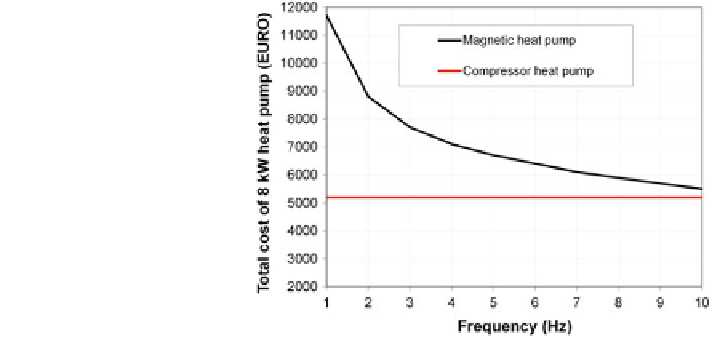Environmental Engineering Reference
In-Depth Information
Fig. 9.11 The manufacturing
costs for the 8-kW heat source
magnetic heat pump and the
equivalent compressor-based
heat pump (data taken from
Egolf et al. [
25
])
Figure
9.11
was made according to the results of the study by Egolf et al. [
25
]. In
Fig.
9.11
the total manufacturing costs for an 8-kW, ground-source, magnetic heat
pump are shown.
Note that the mass of the magnet assembly was underestimated in the study, and
therefore also the costs for the magnet assembly. To be on the safe side the authors
took rather high costs for the other parts of the device (i.e. motor, pumping system,
valves, pipework, housing, etc.). Despite this the results shown in Fig.
9.11
are very
important. Although they do not show exact costs, they demonstrate the importance
of the frequency of the operation of the magnetocaloric device. Since the costs of
the evaluated magnetic heat pump in Egolf et al. [
25
] did not reach the cost of the
compressor-based heat pump, the authors emphasize that by taking into account the
advantage of potentially better efciency and also operating costs, the magnetic heat
pump, operating with a frequency of 5 Hz, will be economically competitive with a
compressor-based heat pump. The issue of high ef
ciency, besides low operating
costs, de
ciency label. This fact must not be missed.
In the study on the applications of magnetic refrigeration (Kitanovski et al. [
26
],
see also Kitanovski and Egolf [
30
]) the authors showed the most important and
feasible market domains for magnetic refrigeration, i.e. household refrigeration,
heat pumps, wine/beverage refrigeration, small medicine refrigeration appliances,
room air conditioners, water cooled chillers, large-scale superconducting chillers,
etc. Based on this study, some further economic evaluations have been performed
by the same group.
In the case of magnetocaloric power generation, Kitanovski et al. [
27
] and Egolf
et al. [
31
] emphasized the use of low-enthalpy heat sources. Furthermore, they
addressed the importance of energy harvesting by applying superconducting
magnets. The same group also performed a comprehensive technical-economic
feasibility study of a magnetocaloric power-conversion system for the utilization of
waste heat [
32
]. In subsequent publications by Vuarnoz et al. in 2012 [
33
,
34
] the
authors found a payback period of 4.9 and 2.4 years (for electricity price 0.1 and 0.2
nes the ef

Search WWH ::

Custom Search